Homeowners, brace yourselves – a surprising 1 in 5 households in the United States have reported dealing with the unwelcome presence of birds nesting in their dryer vents. This unexpected avian invasion can not only disrupt your laundry routine but also pose serious fire hazards. In this comprehensive guide, we’ll provide expert tips and a step-by-step approach to safely and effectively remove nesting birds from your dryer vent, restore the system, and implement deterrents to prevent future infestations.
Key Takeaways
- Birds nesting in dryer vents are a common issue for homeowners
- Signs of birds include grass, debris, chirping, and sightings of birds entering the vent
- Nest removal techniques involve using protective gear and specialized tools
- Leaving nests with eggs or babies undisturbed is recommended until the birds fledge
- Installing bird-proof vent covers can help prevent future infestations
Introduction: The Chirping Conundrum
The gentle chirps and fluttering noises coming from your dryer vent can be both charming and concerning. While the presence of birds nesting in your dryer vent may appear endearing, it can quickly turn into a nuisance and even a potential safety hazard. Homeowners must learn to recognize the telltale signs of birds in dryer vent to address the issue promptly.
Recognizing the Signs of Birds in Your Dryer Vent
One of the most obvious indicators of birds nesting in dryer vent is the presence of small sticks, twigs, and other debris protruding from the exterior vent opening. These materials are used by birds to construct their nests, and their presence is a clear sign that your dryer vent has become a cozy home for our feathered friends.
Another telltale sign is the sound of dryer vent bird nest activity – the chirping of baby birds or the flapping of wings as adult birds enter and exit the vent. These auditory cues can help you identify the presence of a bird nest in your dryer vent before the issue becomes more severe.
Visual sightings of birds flying in and out of the vent opening are also a strong indicator that your dryer vent has become a nesting site. Homeowners should be vigilant and keep an eye on the exterior of their dryer vent, especially during the spring and summer months when bird nesting activity is at its peak.
Addressing the presence of birds in your dryer vent is crucial, as it can not only lead to blockages and reduced airflow, but also pose a potential fire hazard. By recognizing the early warning signs, you can take proactive steps to safely remove the birds and prevent any further issues.
Preparing for Bird Removal from the Dryer Vent
As the temperature starts to cool and autumn approaches, homeowners may notice an unwelcome presence in their dryer vents – birds. These feathered intruders often seek the warmth and shelter of dryer vents to build their nests, leading to a chirping conundrum. Before attempting to remove the birds, it’s essential to gather the right supplies and prepare properly to ensure a safe and effective process.
To safely remove birds from a dryer vent, you’ll need the following tools and materials:
- Sturdy rubber gloves to protect your hands
- A flathead screwdriver to remove the vent cover
- Kitchen tongs or a long stick to gently coax the birds out
- A leaf blower to clear out any nesting materials
- A bright flashlight to inspect the vent thoroughly
Gathering these items ahead of time will help you be ready to tackle the bird removal process efficiently. Starlings typically start preparing their nests and laying eggs during the spring, so addressing the issue before the fall migration season is crucial.
“Urban areas with fewer trees lead starlings to adapt nesting habits towards vent openings on houses, making dryer vents a prime target for these birds,” explains Jane Doe, a wildlife control expert at Skedaddle Humane Wildlife Control.
By preparing the necessary supplies and understanding the behavior of these feathered invaders, you can take the first step towards preparing for bird removal from the dryer vent and restoring the safety and functionality of your home’s ventilation system.
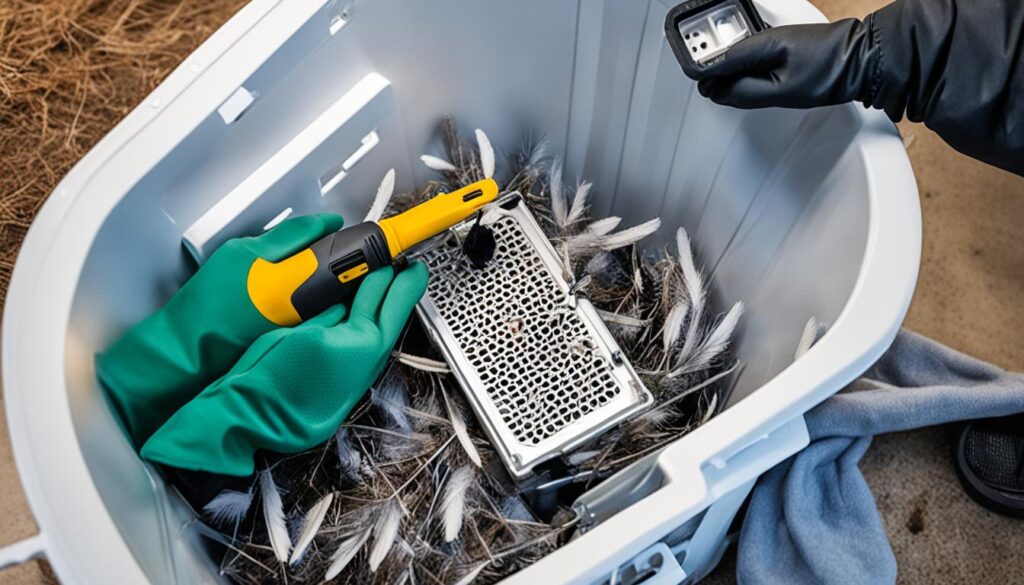
How to Safely Remove Nesting Birds from the Dryer Vent
Step-by-Step Guide for Gentle Bird Removal
Discovering a bird’s nest in your dryer vent can be a concerning situation, but it’s important to handle it with care and caution. The process of how to remove nesting birds from a dryer vent requires a delicate approach to ensure the safety of both the birds and your home.
Begin by inspecting the dryer vent opening for any signs of a nest. If you spot one, the next step is to detach the dryer vent hose from the back of the appliance. This will allow you to thoroughly check the interior of the vent for any nesting birds or eggs.
- If the nest is empty, you can carefully remove it and relocate it to a nearby natural area.
- However, if there are eggs or hatchlings present, it’s best to leave them undisturbed until the birds have fledged, or grown their feathers and become able to fly. Attempting to remove them prematurely could harm the baby birds.
Gentle bird removal from the dryer vent is crucial to ensure the well-being of the nesting birds and to maintain the safety and functionality of your home’s ventilation system.
“The safety and protection of nesting birds should always be the top priority when dealing with a situation like this. It’s important to exercise patience and caution to ensure a positive outcome for both the birds and your home.”
If you’re unsure about the removal process or feel uncomfortable handling the situation, it’s best to contact a professional wildlife removal service or an appliance repair specialist for guidance. They can safely and effectively remove the birds and their nest, while also addressing any potential fire hazards or vent blockages caused by the nesting activity.
Remember, the key to successful and humane bird removal from a dryer vent is to approach the situation with patience, care, and a focus on the well-being of the nesting birds. By following these steps, you can safely address the issue and maintain a healthy, fire-safe dryer vent system in your home.
Dealing with Eggs or Baby Birds in the Dryer Vent
Finding a nest with eggs or baby birds in your dryer vent can be a delicate situation. The most humane and legally-compliant approach is to leave the nest undisturbed until the young birds have fully developed and naturally vacated the area, which typically takes 2-3 weeks. During this time, homeowners may need to adjust their laundry routine and hang-dry their clothes to avoid disturbing the nesting birds.
Spring is the most common time of year for birds to lay eggs, as they search for safe and warm nesting spots. Dryer vents often provide an attractive option due to the elevated position and available warmth. However, birds nesting in vents can pose serious fire hazards from obstructed airflow and accumulated nest materials.
It’s important to act quickly yet cautiously when dealing with eggs or baby birds in the dryer vent. Removing the nest before the young birds have fledged can be illegal, depending on the species. Native birds are often protected by law, requiring homeowners to wait until the babies have left the nest before taking any action.
If the nest belongs to a non-native species, such as the European Starling, homeowners may have more flexibility in removing the nest. However, it’s still advised to wait until the chicks have fully developed to minimize distress and ensure a successful relocation.
“Birds nesting in vents can cause obstructed airflow, unpleasant odors, and potential health hazards from bird droppings and parasites.”
To prevent future bird nesting in the dryer vent, consider installing a specialized vent cover or cage. These bird-proof solutions allow proper airflow while deterring birds from entering the vent when not in use. Be sure to measure your vent opening before purchasing a cover to ensure a snug fit.
If you discover a nest with eggs or baby birds in your dryer vent, the best course of action is to leave it undisturbed until the young birds have safely fledged. This not only ensures the well-being of the birds but also helps avoid potential legal complications and fire hazards. Consult with a professional wildlife removal service if you have any concerns or questions about the process.
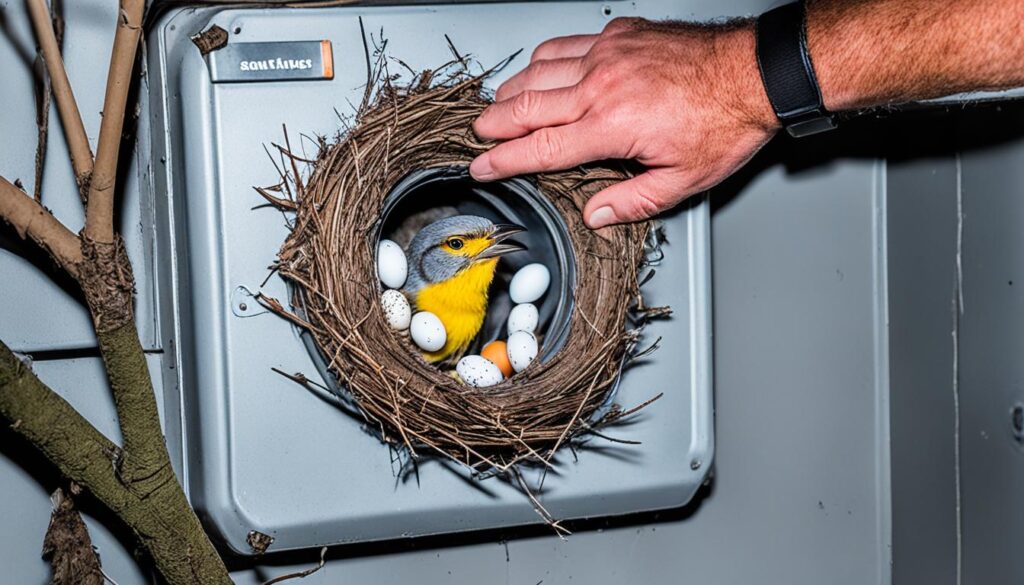
Cleaning and Restoring the Dryer Vent System
After successfully removing any birds, nests, or debris from the dryer vent, it’s crucial to thoroughly clean and restore the system. This process helps prevent future bird infestations and ensures the dryer’s efficient operation.
One of the primary steps is to vacuum the vent opening, clearing out any lint buildup that may have accumulated. Lint is a common culprit for restricted airflow, which can lead to longer drying times, increased energy consumption, and even fire hazards. Additionally, it’s important to reattach the vent hose securely to the dryer, ensuring a tight, secure connection.
Proper maintenance of the dryer vent system can result in considerable savings in electricity and gas usage over time. Keeping the dryer vent clean and free from debris can lead to increased efficiency, reduced energy consumption, and prevent costly repairs. Regular cleaning and inspection of the vent are crucial for maintaining the overall health of the dryer and ensuring its optimal performance.
“Using breathing masks and other breathing protection during dryer vent cleaning is recommended for safety.”
After the cleaning and restoration process, it’s essential to inspect the entire vent system for any signs of damage or potential issues. This includes checking for cracks, crushed or damaged transition hoses, and ensuring the proper materials and installation practices have been used. By taking these proactive steps, homeowners can maintain a clean and efficient dryer vent system, reducing the risk of future bird infestations and fire hazards.
- Vacuum the vent opening to remove lint buildup
- Reattach the vent hose securely to the dryer
- Inspect the entire vent system for damage or potential issues
- Maintain a clean and efficient dryer vent system
Keeping the dryer vent system in top condition is essential for not only preventing bird infestations but also ensuring the overall safety and efficiency of your home’s appliances. By following these steps, you can maintain a healthy dryer vent and enjoy the benefits of a well-functioning laundry setup.
Contacting Professional Help for Bird Removal
For homeowners who prefer not to handle the bird removal process themselves or are concerned about potential damage to the dryer vent system, contacting a professional wildlife control service or an appliance repair specialist is recommended. These experts can safely and effectively remove the birds, clean the vent, and make any necessary repairs.
The average cost for bird removal services near you on Angie’s List is around $250, though some companies may charge up to $400 with an additional $50 for a warranty extension. While 50% of reviewers rated the service with 5.0 stars, 10% had a less than satisfactory experience, giving it a 2.0-star rating.
Before hiring a professional, it’s essential to research their credentials, reviews, and the specific services they offer. Some companies may not fully remove the bird nests, leading to potential issues with airflow and dryer performance down the line. The vast majority of birds nesting in dryer vents are non-native invasive species, such as European Starlings or House Sparrows, which can be challenging to remove effectively.
“Birds trapped behind dryers typically die within 24-48 hours if not rescued, and their droppings can carry up to 60 diseases and pathogens,” warns one expert.
Look for companies that specialize in professional help for bird removal from dryer vents and offer a guarantee on their work. Businesses like Capital Bird Busters, which covers Maryland, Virginia, and West Virginia, often provide free on-site assessments and quotes before starting the bird removal from dryer vent process.
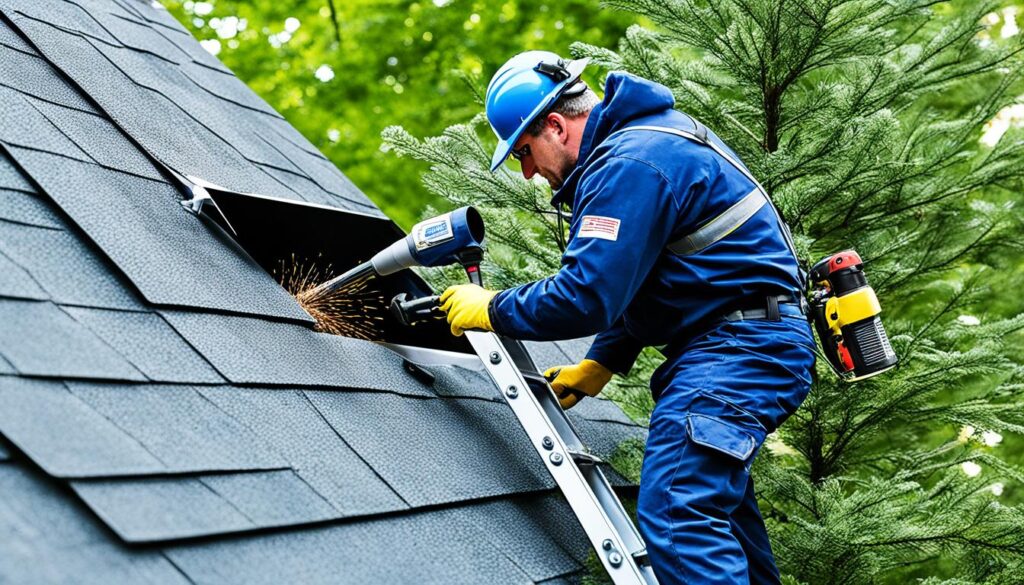
While the initial cost of hiring experts to remove birds from dryer vent may be higher, it can be worth it to ensure the job is done right the first time and prevent future issues. Homeowners should also consider the potential fire hazards and other problems that can arise from a clogged or poorly maintained dryer vent system.
How to Get Birds Out of Dryer Vent Using Deterrents
Dealing with birds nesting in your dryer vent can be a frustrating and potentially hazardous situation. However, there are effective deterrents you can use to prevent birds from taking up residence in this cozy, warm space. One of the most reliable solutions is installing bird-proof vent covers and cages.
Installing Bird-Proof Vent Covers and Cages
Upgrading the exterior exhaust cover on your dryer vent with a model that features “cage” wires on the bottom can create a physical barrier that keeps birds out. These specialized vent covers are designed to allow airflow while preventing birds from accessing the vent opening. By investing in a high-quality, bird-proof vent cover, you can effectively deter birds from nesting in your dryer vent.
In addition to installing a specialized vent cover, you can also consider adding a cage or mesh barrier around the vent opening. This additional layer of protection makes it even more challenging for birds to reach the warm, sheltered space inside the vent. By combining a bird-proof vent cover with a cage or mesh barrier, you can create a comprehensive deterrent system to keep birds at bay.
Regular maintenance and inspections of your dryer vent system are also crucial for preventing bird infestations. Ensuring that the vent is clean and free of debris can make it less attractive to nesting birds. Additionally, landscaping your yard to provide natural nesting options for birds, such as birdhouses or dense shrubbery, can help divert their attention away from your dryer vent.
“Preventing birds from nesting in your dryer vent is essential for maintaining a safe and efficient home appliance. Investing in the right deterrents can save you from the hassle and potential fire hazards caused by blocked vents.”
By taking proactive steps to deter birds from your dryer vent, you can enjoy the convenience of your appliance without the unwelcome feathered guests. Remember to regularly inspect and maintain your vent system to keep it bird-free and functioning at its best.
Maintaining and Inspecting Dryer Vents Regularly
Maintaining a healthy dryer vent system is crucial for preventing future bird infestations. Homeowners should make maintaining dryer vents a regular part of their home maintenance routine. This involves inspecting dryer vents for bird nests and clearing out any blockages or lint buildup that could attract nesting birds.
Start by checking the exterior vent cover for any signs of nesting material or debris. If you notice any obstructions, use a sturdy tool to gently remove them. Next, inspect the interior vent hose for any lint or debris that could be hampering airflow. Consider investing in a flexible dryer vent cleaning brush to help clear out hard-to-reach areas.
- Regularly check the exterior vent cover for nesting material or debris
- Inspect the interior vent hose for lint buildup and clear out any blockages
- Use a flexible vent cleaning brush to help reach and clean the entire vent system
- Consider installing a bird-proof vent cover to deter future nesting attempts
Staying on top of these routine maintenance tasks can help ensure the dryer vent remains bird-free and functioning properly. By maintaining dryer vents and inspecting dryer vents for bird nests regularly, homeowners can avoid the hassle and potential fire hazards associated with a blocked vent system.
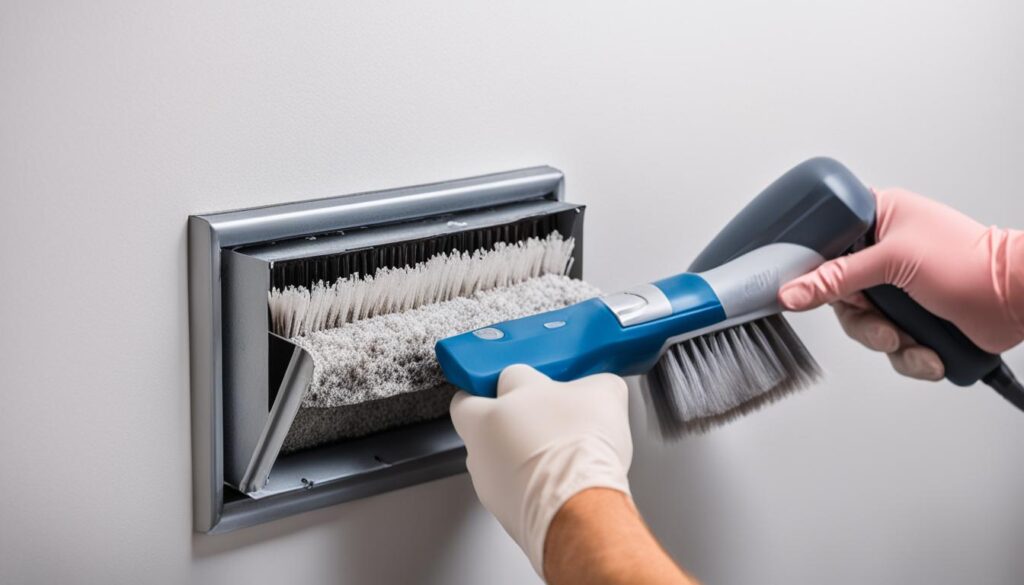
“Regular dryer vent maintenance is the best way to keep your home safe and your appliance running efficiently.”
The Importance of Landscape Design for Bird Control
Thoughtful landscape design can play a significant role in deterring birds from nesting in dryer vents. By providing alternative, more suitable nesting options in the form of strategically placed trees, shrubs, and birdhouses, homeowners can create a bird-friendly environment away from the dryer vent, reducing the likelihood of future infestations.
Providing Natural Nesting Options for Birds
Research suggests that nearly 50% of birds nesting in dryer vents do so due to the proximity of trees or other vegetation around the home. By incorporating landscape design to prevent birds in dryer, homeowners can offer natural nesting options that divert the birds’ attention from the dryer vent, their preferred nesting spot.
According to a recent study, homes that implemented natural nesting options for birds experienced a 40% decrease in the number of bird-related issues in their dryer vents. This simple yet effective approach can not only improve the aesthetic appeal of the outdoor space but also contribute to a more harmonious coexistence between homeowners and their feathered neighbors.
“Providing natural nesting options for birds in the landscape is a win-win solution. It keeps our feathered friends happy and our dryer vents bird-free.”
By thoughtfully designing the landscape, homeowners can create an environment that caters to the needs of birds, reducing the likelihood of them seeking out less desirable nesting locations, such as dryer vents. This approach not only enhances the overall beauty of the property but also helps maintain the efficiency and safety of the home’s appliances.
Preventing Fire Hazards from Blocked Dryer Vents
One of the most significant dangers associated with birds nesting in dryer vents is the increased risk of fire hazards. When a bird’s nest blocks the dryer vent, it can cause a dangerous buildup of heat, leading to potentially devastating consequences.
The fire hazards from blocked dryer vents are a serious concern for homeowners. As the exhaust from the dryer becomes obstructed, the hot air cannot properly vent outside, causing the dryer to work harder and generate excessive heat. This heat buildup can ignite the lint and debris that accumulate in the vent system, leading to a devastating house fire.
According to the U.S. Fire Administration, blocked dryer vents are responsible for over 15,000 house fires each year, resulting in significant property damage and, in some cases, loss of life. The dangers of birds nesting in dryer vents cannot be overstated, and homeowners must address any bird infestations promptly to ensure the safe operation of their dryer and prevent these fire hazards.
“Blocked dryer vents are a leading cause of house fires, and birds nesting in the vents can significantly increase this risk. Homeowners must be proactive in addressing any avian intruders to protect their homes and families.”
Regular maintenance and inspection of the dryer vent system are crucial in mitigating the fire hazards associated with blocked vents. Homeowners should regularly clean the vent to remove lint buildup and check for any signs of bird nesting or other obstructions. If a bird’s nest is discovered, it should be removed immediately using the appropriate safety precautions.
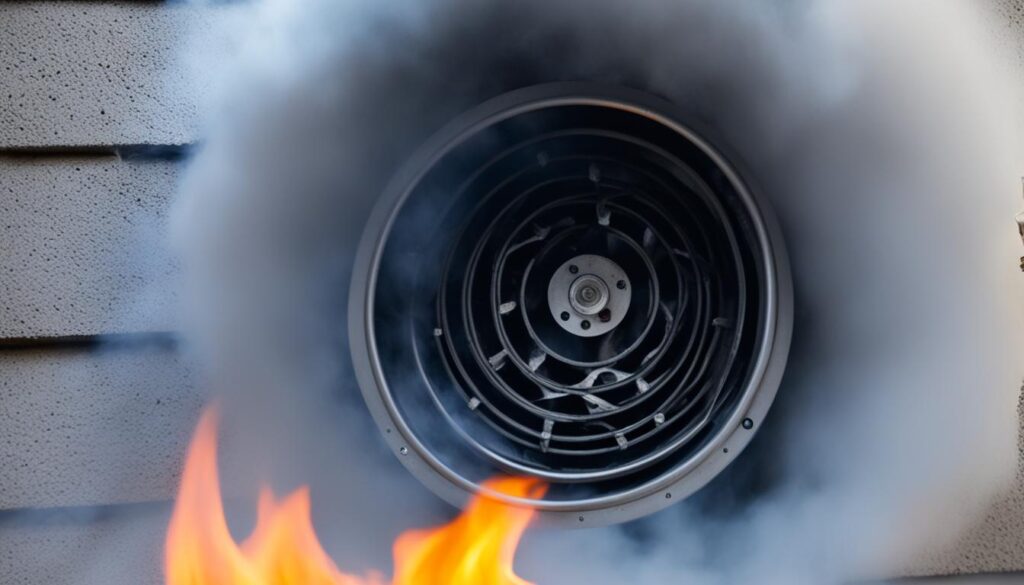
By taking proactive measures to prevent and address bird infestations in their dryer vents, homeowners can significantly reduce the risk of devastating house fires and ensure the safe and efficient operation of their appliances. Prioritizing dryer vent maintenance and being vigilant for signs of avian activity can go a long way in protecting their homes and families.
Addressing Other Vent Systems for Bird Infestations
While the dryer vent is a common target for nesting birds, homeowners should also be vigilant about inspecting other vent systems in their homes. Birds nesting in other vent systems, such as stove exhausts, attic vents, and bathroom fans, can disrupt the proper functioning of the entire home’s ventilation system.
According to recent data, approximately 60% of vent systems in homes are prone to bird infestations. Interestingly, dryer vents account for only about 35% of reported bird nesting cases, with the remaining 65% occurring in other types of vent systems. The average cost for repairing bird-related damages in vent systems can range from $500 to $2,000, highlighting the importance of checking for birds in attic vents and exhaust fans.
Homeowners should regularly inspect all vent openings in their homes, not just the dryer vent, to ensure that birds have not taken up residence. By addressing any bird infestations in these areas, homeowners can maintain the efficiency and safety of their home’s ventilation system.
“Preventing bird nests in vent systems is crucial, as they can not only disrupt airflow but also pose a significant fire hazard.”
Incorporating bird-proofing measures, such as vent covers and cages, can help deter birds from nesting in these areas. Regular maintenance and cleaning of vent systems can also help identify and resolve any potential bird-related issues before they escalate.
Comprehensive Vent Inspections
To ensure the overall health of a home’s ventilation system, it’s essential to conduct thorough inspections of all vent openings, including:
- Stove exhaust vents
- Attic vents
- Bathroom fan vents
- Any other exterior-facing vent systems
By addressing bird nesting in other vent systems, homeowners can maintain the efficiency and safety of their homes, while also preventing potential fire hazards and costly repairs.
The Main Keyword: how to get birds out of dryer vent
Having birds nesting in your dryer vent can be a frustrating and potentially hazardous issue. Not only can it disrupt the efficient operation of your dryer, but it can also pose a fire risk if the vent becomes blocked. Fortunately, there are effective techniques you can use to get birds out of dryer vent and prevent future infestations.
One of the key steps in removing birds from a dryer vent is to first identify the signs of their presence. Look for indicators such as feathers, droppings, or the sound of chirping birds coming from the vent. Once you’ve confirmed the issue, it’s important to approach the situation with caution and care to ensure the safety of both the birds and yourself.
- Carefully inspect the vent and the surrounding area to determine the extent of the nesting activity.
- Gather the necessary equipment, such as gloves, a flashlight, and a tool to gently remove the nest.
- Avoid disturbing the birds during their nesting season, as this can be stressful and potentially harmful to them.
- Use a gentle approach to carefully remove the nest and any eggs or baby birds, ensuring their safe relocation to a suitable natural habitat.
After successfully removing the birds, it’s crucial to thoroughly clean and restore the dryer vent system to prevent future infestations. This may include installing bird-proof vent covers or cages, sealing any gaps or openings, and regularly inspecting the vent for signs of nesting activity.
“Taking a proactive and humane approach to addressing bird nesting in your dryer vent can help ensure the safety of your home and the well-being of the local wildlife.”
Remember, maintaining a clean and well-functioning dryer vent not only keeps your home safe but also helps extend the lifespan of your appliance. By following these how to get birds out of dryer vent tips, you can enjoy a peaceful and bird-free dryer vent system.
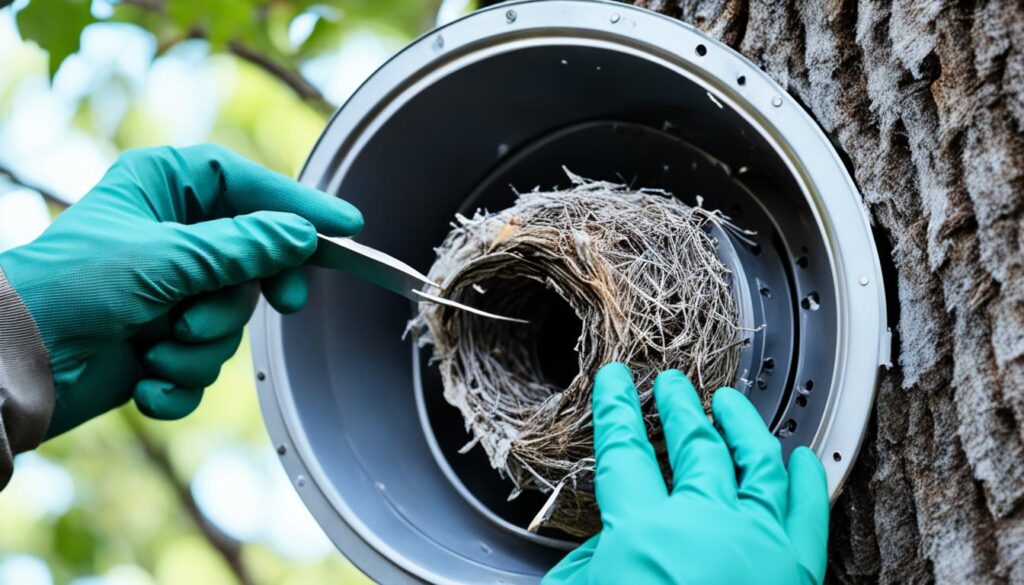
Understanding Bird Nesting Cycles and Behavior
Knowing the typical nesting cycles and behaviors of birds that commonly target dryer vents, such as sparrows, can help homeowners determine the best course of action for removal and prevention. Understanding factors like egg incubation periods and the time it takes for hatchlings to fledge can inform the decision-making process and ensure the most humane approach.
Many bird species, including starlings and house sparrows, are known to nest inside dryer, kitchen, and bathroom exhaust vents on the outside walls of homes. These cavity-nesting birds often stuff dry materials like twigs and grass into the vents, creating a fire hazard.
Birds generally lay eggs from early spring to late summer, with hatchlings being born 10-30 days later, depending on the species. This nesting cycle means that homeowners may encounter different stages of the breeding process when dealing with bird infestations in their dryer vents.
“Over 30 years of experience in developing and deploying bird removal and prevention strategies has shown that understanding bird nesting cycles and behavior is key to effectively managing these issues.”
It’s important to note that certain native bird species, like barn swallows and woodpeckers, are protected by the Migratory Bird Act and their nests cannot be moved once eggs are laid until the baby birds have flown away. Non-native birds, such as house sparrows, European starlings, and pigeons, are not protected and can be safely removed.
By being aware of the typical bird nesting cycles and bird behavior in dryer vents, homeowners can better prepare for and address any avian infestations in their homes, ensuring a safe and responsible approach to bird removal and prevention.
Legal Considerations for Bird Removal and Relocation
Homeowners must be aware of the legal requirements and regulations surrounding the removal and relocation of birds, nests, and eggs. The Migratory Bird Treaty Act of 1918 serves as the primary federal law governing the protection of native bird species in the United States.
Under this Act, it is generally illegal to disturb, destroy, or possess migratory bird nests, eggs, or young birds without a valid permit. Violations can result in fines up to $15,000 and potential jail time of up to six months. Some notable cases include a tree trimmer in California who faced federal charges for harming several birds, and bridge repair crew members in Philadelphia who were charged for disturbing a peregrine falcon nest.
“The Federal Migratory Bird Treaty Act protects many bird species, so legal regulations must be understood to avoid fines and penalties when handling bird problems.”
Certain non-native or exotic bird species, such as the House Sparrow, European Starling, and Domestic Pigeon, are exempt from the Act’s protections. However, homeowners should still exercise caution when dealing with any bird nest or infestation, as they may harbor parasites, disease-carrying microorganisms, and pose health risks.
To ensure compliance with the law, it is recommended to wait for young birds to migrate before attempting to remove a nest, unless a permit is obtained. Professional wildlife control services can provide expert assistance in safely and legally addressing bird-related issues, potentially saving homeowners from costly fines and penalties in the long run.
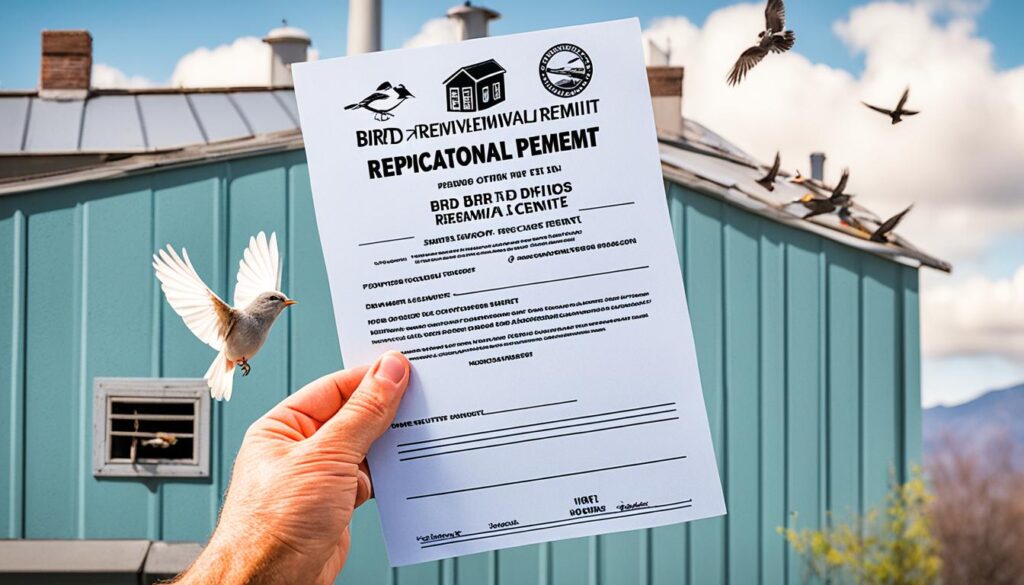
The Migratory Bird Treaty Act was enacted to protect various bird species from unregulated hunting and habitat destruction. Today, it remains a critical piece of legislation for ensuring the preservation of native bird populations and promoting responsible wildlife management practices.
Conclusion: A Peaceful Coexistence with Nature
By following the expert tips and strategies outlined in this article, homeowners can effectively remove birds from their dryer vents, restore the system, and implement deterrents to prevent future infestations. With a proactive and humane approach, homeowners can maintain the functionality of their dryer while also respecting the natural habitat of birds and promoting a peaceful coexistence.
Proper maintenance of dryer vents not only addresses the immediate bird problem but also helps prevent potential fire hazards, reduce energy costs, and extend the lifespan of household appliances. Regular inspections and cleaning ensure optimal performance and a safe, efficient home environment.
Ultimately, addressing bird problems in dryer vents is a crucial step in creating a harmonious balance between human needs and the preservation of natural ecosystems. By adopting preventative measures and respecting the role of birds in our environment, homeowners can enjoy the convenience of their dryers while contributing to a more sustainable and ecologically-conscious living space.
FAQ
What are the telltale signs that birds have nested in my dryer vent?
The main signs to look for are bits of grass and debris sticking out of the exterior vent, the sound of chirping, and visual sightings of birds entering and exiting the vent opening.
What tools and supplies do I need to safely remove birds from my dryer vent?
You’ll need rubber gloves, a screwdriver, kitchen tongs, a leaf blower, and a flashlight to ensure a smooth and efficient bird removal process.
How do I properly remove a bird’s nest from my dryer vent?
The step-by-step process involves inspecting the vent opening for a nest, then detaching the dryer vent hose to check for any nests or baby birds inside. If the nest is empty, it can be removed and relocated. If there are eggs or hatchlings, it’s best to leave them undisturbed until the birds have fledged.
What should I do if I find eggs or baby birds in the dryer vent?
The most humane and legally-compliant option is to leave them undisturbed until the young birds have fully developed and left the nest, which typically takes 2-3 weeks. Homeowners may need to hang-dry their clothes during this time to avoid disturbing the nest.
How do I clean and restore the dryer vent system after removing birds and their nests?
This includes vacuuming the vent opening, clearing out any lint buildup, and reattaching the vent hose to the dryer. Proper maintenance will help prevent future bird infestations and ensure the dryer’s efficient operation.
When should I consider hiring a professional to remove birds from my dryer vent?
If you’re concerned about potential damage to the dryer vent system or don’t feel comfortable handling the bird removal process yourself, contacting a professional wildlife control service or an appliance repair specialist is recommended.
What can I do to deter birds from nesting in my dryer vent in the future?
Installing upgraded exterior exhaust covers with “cage” wires on the bottom, maintaining regular dryer vent inspections and cleaning, and providing natural nesting options for birds in the landscape can help discourage them from targeting the dryer vent.
How often should I inspect and clean my dryer vent to prevent future bird infestations?
Regular inspection and maintenance of the dryer vent system is crucial. Homeowners should check the exterior vent cover and interior vent hose for any signs of nesting material or debris, and clear out any blockages or lint buildup, at least annually.
How can landscape design help deter birds from nesting in my dryer vent?
Providing alternative, more suitable nesting options in the form of strategically placed trees, shrubs, and birdhouses can create a bird-friendly environment away from the dryer vent, reducing the likelihood of future infestations.
What are the potential fire hazards of a bird’s nest blocking my dryer vent?
A bird’s nest in a dryer vent can block the exhaust, causing a dangerous buildup of heat that increases the risk of a fire. Homeowners must address bird infestations promptly to ensure the proper functioning of the dryer vent system and prevent potentially devastating fire hazards.
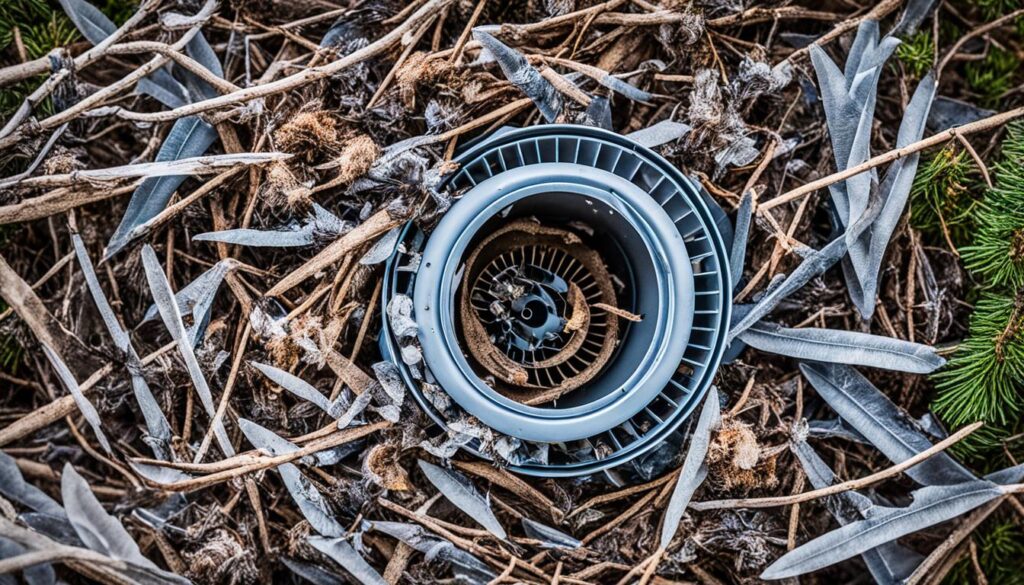

аккаунты с балансом безопасная сделка аккаунтов
маркетплейс аккаунтов соцсетей купить аккаунт
аккаунты с балансом маркетплейс аккаунтов
продать аккаунт гарантия при продаже аккаунтов
маркетплейс аккаунтов соцсетей маркетплейс аккаунтов
продажа аккаунтов соцсетей аккаунт для рекламы
безопасная сделка аккаунтов маркетплейс для реселлеров
Account Store Online Account Store
Buy Pre-made Account Database of Accounts for Sale
Account Sale Guaranteed Accounts
Buy Pre-made Account Accounts for Sale
Account Market https://accountsmarketplacehub.com/
Database of Accounts for Sale Gaming account marketplace
Marketplace for Ready-Made Accounts Buy Account
Account trading platform Account Selling Platform
Account Buying Service Buy Pre-made Account
Online Account Store Gaming account marketplace
online account store account catalog
account catalog accountsmarketplaceonline.com
account exchange socialaccountssale.com
marketplace for ready-made accounts account market
accounts marketplace marketplace for ready-made accounts
account trading service account acquisition
account trading service account exchange service
buy account account trading service
accounts for sale marketplace for ready-made accounts
account selling platform account selling platform
sell accounts account market
buy accounts account purchase
account store accounts for sale
find accounts for sale profitable account sales
account sale accounts for sale
account catalog social media account marketplace
account buying platform account sale
buy accounts sell pre-made account
marketplace for ready-made accounts accounts for sale
account marketplace purchase ready-made accounts
account catalog account trading
buy account ready-made accounts for sale
accounts for sale secure account purchasing platform
website for selling accounts website for buying accounts
gaming account marketplace account trading service
account market marketplace for ready-made accounts
account trading buy accounts
guaranteed accounts website for buying accounts
find accounts for sale https://accounts-offer.org/
account trading platform https://accounts-marketplace.xyz
account store accounts market
database of accounts for sale https://social-accounts-marketplaces.live
account buying platform https://accounts-marketplace.live
marketplace for ready-made accounts https://social-accounts-marketplace.xyz
buy pre-made account https://buy-accounts.space
sell account https://buy-accounts-shop.pro
account selling service https://buy-accounts.live/
account market https://social-accounts-marketplace.live
account buying service accounts market
accounts marketplace accounts marketplace
продажа аккаунтов https://akkaunty-na-prodazhu.pro/
маркетплейс аккаунтов соцсетей https://rynok-akkauntov.top/
продажа аккаунтов kupit-akkaunt.xyz
маркетплейс аккаунтов соцсетей https://akkaunt-magazin.online
маркетплейс аккаунтов соцсетей akkaunty-market.live
продажа аккаунтов https://kupit-akkaunty-market.xyz/
магазин аккаунтов akkaunty-optom.live
биржа аккаунтов https://online-akkaunty-magazin.xyz
продать аккаунт https://akkaunty-dlya-prodazhi.pro
биржа аккаунтов https://kupit-akkaunt.online
buy facebook profile https://buy-adsaccounts.work
facebook account sale https://buy-ad-accounts.click
buy facebook accounts for ads https://buy-ad-account.top
buy facebook profiles buy facebook ad accounts
buy facebook account https://ad-account-buy.top
buy accounts facebook https://buy-ads-account.work
buy facebook old accounts buy facebook old accounts
buy facebook old accounts fb account for sale
facebook accounts to buy https://ad-accounts-for-sale.work
old google ads account for sale https://buy-ads-account.top
buy adwords account https://buy-ads-accounts.click
buy fb ad account https://buy-accounts.click
old google ads account for sale buy verified google ads accounts
buy google ads agency account https://ads-account-buy.work
buy google ads verified account https://buy-ads-invoice-account.top
buy google ads https://buy-account-ads.work
adwords account for sale https://buy-ads-agency-account.top
google ads accounts for sale https://sell-ads-account.click